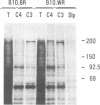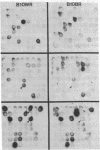Abstract
cDNA clones carrying parts of murine fourth complement component (C4, serum substance protein) mRNA sequences have been identified by differential hybridization to mRNA from a high C4-producing strain, B10.WR, and a congeneic low C4 strain, B10.BR, followed by hybrid-selected translation and DNA sequence analysis. One clone, pMLC4/w7-2, encodes an open amino acid reading frame that includes four tandem arginine residues immediately preceding a sequence 85% homologous with the NH2-terminal sequence of the human C4 gamma-chain. The amino acid composition of the predicted sequence upstream of the tandem arginines matches quite closely with the composition of a similar sized peptide at the COOH terminus of the human C4 alpha chain. The latter result raises questions regarding the nature and extent of plasma-mediated postsynthetic processing of the C4 alpha-chain COOH terminus. The results also demonstrate that strain differences in plasma C4 levels (low C4 vs. high C4) reflect differences in steady-state levels of liver C4 mRNA in these strains.
Full text
PDF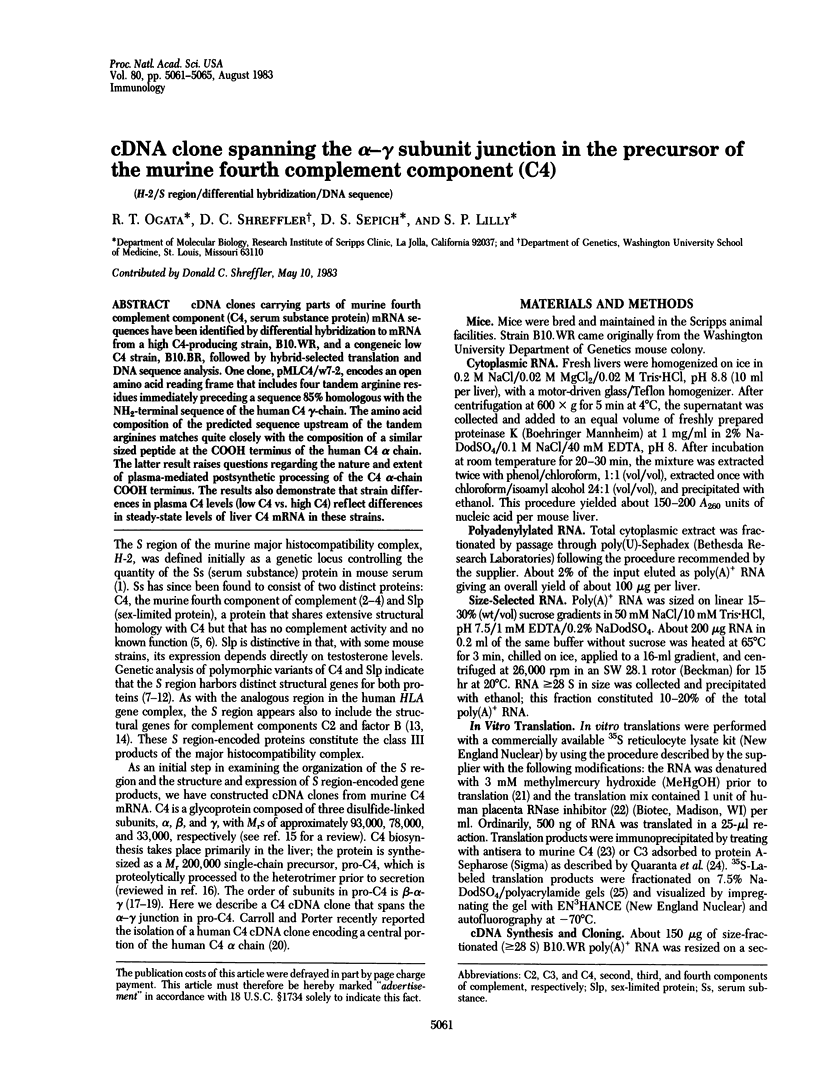
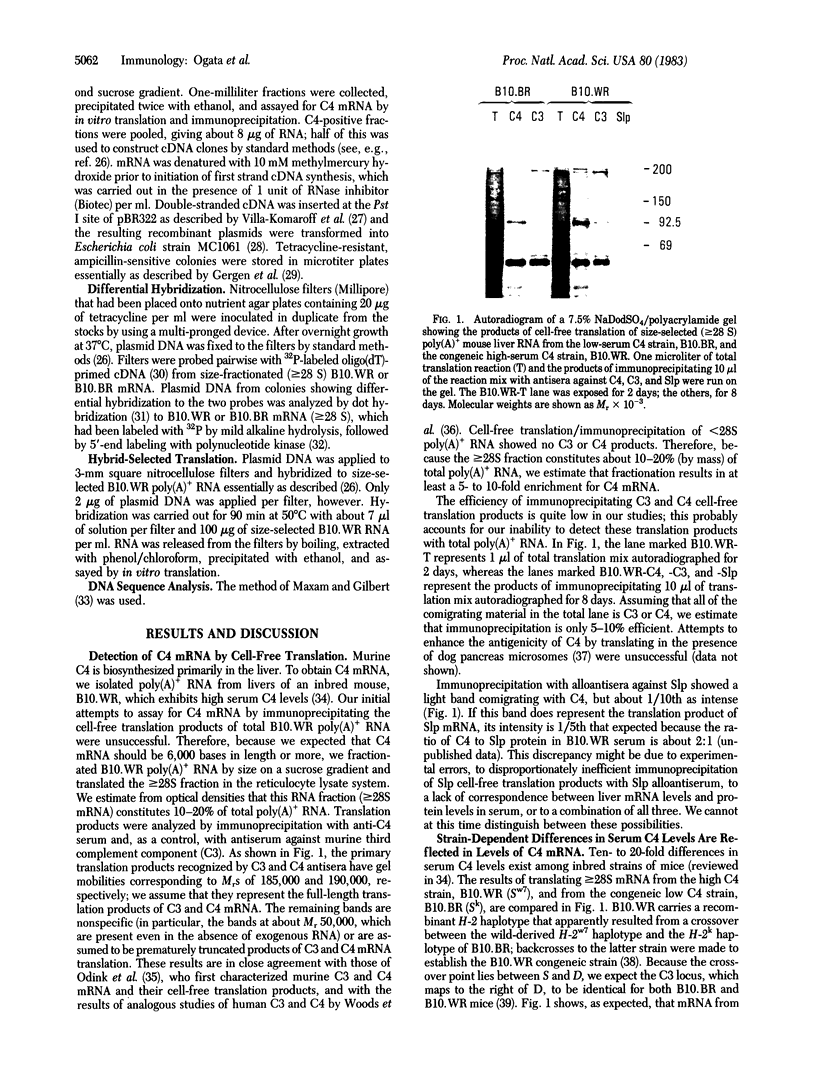
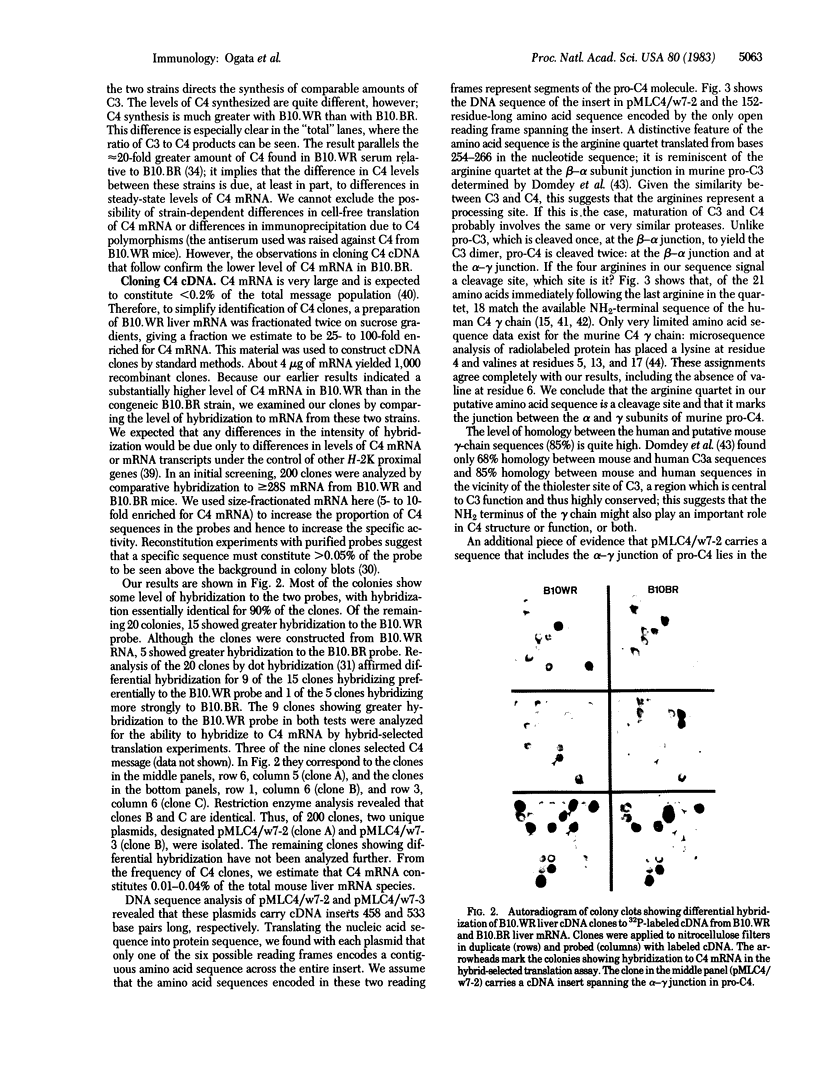
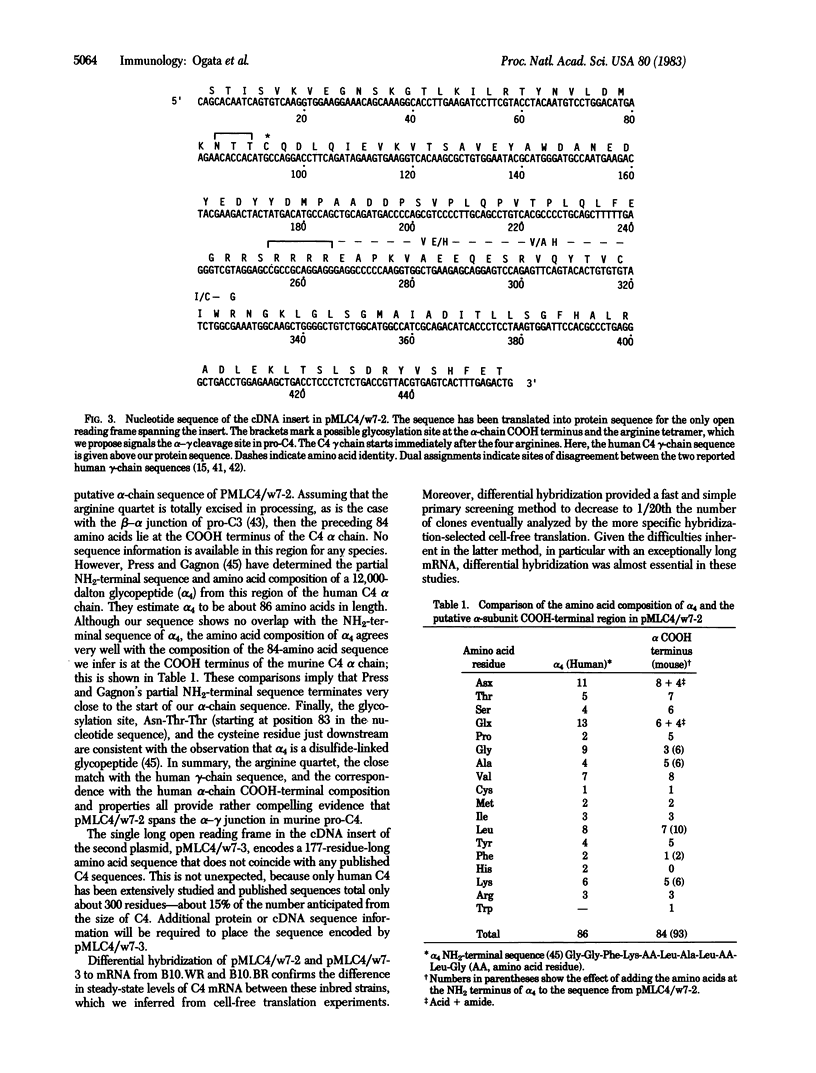
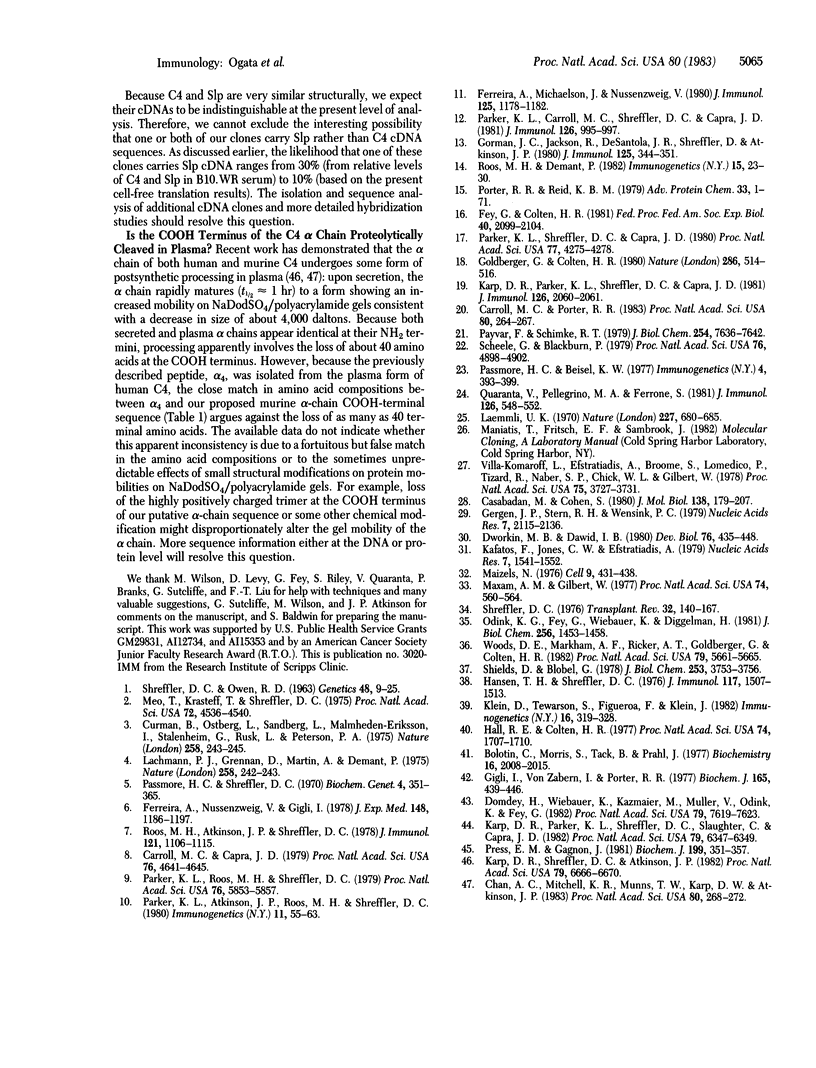
Images in this article
Selected References
These references are in PubMed. This may not be the complete list of references from this article.
- Bolotin C., Morris S., Tack B., Prahl J. Purification and structural analysis of the fourth component of human complement. Biochemistry. 1977 May 3;16(9):2008–2015. doi: 10.1021/bi00628a039. [DOI] [PubMed] [Google Scholar]
- Carroll M. C., Capra J. D. Studies on murine Ss protein: demonstration that S region encodes structural gene for fourth component of complement. Proc Natl Acad Sci U S A. 1979 Sep;76(9):4641–4645. doi: 10.1073/pnas.76.9.4641. [DOI] [PMC free article] [PubMed] [Google Scholar]
- Carroll M. C., Porter R. R. Cloning of a human complement component C4 gene. Proc Natl Acad Sci U S A. 1983 Jan;80(1):264–267. doi: 10.1073/pnas.80.1.264. [DOI] [PMC free article] [PubMed] [Google Scholar]
- Casadaban M. J., Cohen S. N. Analysis of gene control signals by DNA fusion and cloning in Escherichia coli. J Mol Biol. 1980 Apr;138(2):179–207. doi: 10.1016/0022-2836(80)90283-1. [DOI] [PubMed] [Google Scholar]
- Chan A. C., Mitchell K. R., Munns T. W., Karp D. R., Atkinson J. P. Identification and partial characterization of the secreted form of the fourth component of human complement: evidence that it is different from major plasma form. Proc Natl Acad Sci U S A. 1983 Jan;80(1):268–272. doi: 10.1073/pnas.80.1.268. [DOI] [PMC free article] [PubMed] [Google Scholar]
- Curman B., Ostberg L., Sandberg L., Malmheden-Eriksson I., Stålenheim G., Rask L., Peterson P. A. H-2 linked Ss protein is C4 component of complement. Nature. 1975 Nov 20;258(5532):243–245. doi: 10.1038/258243a0. [DOI] [PubMed] [Google Scholar]
- Domdey H., Wiebauer K., Kazmaier M., Müller V., Odink K., Fey G. Characterization of the mRNA and cloned cDNA specifying the third component of mouse complement. Proc Natl Acad Sci U S A. 1982 Dec;79(24):7619–7623. doi: 10.1073/pnas.79.24.7619. [DOI] [PMC free article] [PubMed] [Google Scholar]
- Dworkin M. B., Dawid I. B. Construction of a cloned library of expressed embryonic gene sequences from Xenopus laevis. Dev Biol. 1980 May;76(2):435–448. doi: 10.1016/0012-1606(80)90392-9. [DOI] [PubMed] [Google Scholar]
- Ferreira A., Michaelson J., Nussenzweig V. A polymorphism of the gamma-chain of mouse C4 controlled by the S region of the major histocompatibility complex. J Immunol. 1980 Sep;125(3):1178–1182. [PubMed] [Google Scholar]
- Ferreira A., Nussenzweig V., Gigli I. Structural and functional differences between the H-2 controlled Ss and Slp proteins. J Exp Med. 1978 Nov 1;148(5):1186–1197. doi: 10.1084/jem.148.5.1186. [DOI] [PMC free article] [PubMed] [Google Scholar]
- Fey G., Colten H. R. Biosynthesis of complement components. Fed Proc. 1981 May 15;40(7):2099–2104. [PubMed] [Google Scholar]
- Gergen J. P., Stern R. H., Wensink P. C. Filter replicas and permanent collections of recombinant DNA plasmids. Nucleic Acids Res. 1979 Dec 20;7(8):2115–2136. doi: 10.1093/nar/7.8.2115. [DOI] [PMC free article] [PubMed] [Google Scholar]
- Gigli I., von Zabern I., Porter R. R. The isolation and structure of C4, the fourth component of human complement. Biochem J. 1977 Sep 1;165(3):439–446. doi: 10.1042/bj1650439. [DOI] [PMC free article] [PubMed] [Google Scholar]
- Goldberger G., Colten H. R. Precursor complement protein (pro-C4) is converted in vitro to native C4 by plasmin. Nature. 1980 Jul 31;286(5772):514–516. doi: 10.1038/286514a0. [DOI] [PubMed] [Google Scholar]
- Gorman J. C., Jackson R., Desantola J. R., Shreffler D., Atkinson J. P. Development of a hemolytic assay for mouse C2 and determination of its genetic control. J Immunol. 1980 Jul;125(1):344–351. [PubMed] [Google Scholar]
- Hall R. E., Colten H. R. Cell-free synthesis of the fourth component of guinea pig complement (C4): identification of a precursor of serum C4 (pro-C4). Proc Natl Acad Sci U S A. 1977 Apr;74(4):1707–1710. doi: 10.1073/pnas.74.4.1707. [DOI] [PMC free article] [PubMed] [Google Scholar]
- Hansen T. H., Shreffler D. C. Characterization of a constitutive variant of the murine serum protein allotype, Slp. J Immunol. 1976 Nov;117(5 Pt 1):1507–1513. [PubMed] [Google Scholar]
- Kafatos F. C., Jones C. W., Efstratiadis A. Determination of nucleic acid sequence homologies and relative concentrations by a dot hybridization procedure. Nucleic Acids Res. 1979 Nov 24;7(6):1541–1552. doi: 10.1093/nar/7.6.1541. [DOI] [PMC free article] [PubMed] [Google Scholar]
- Karp D. R., Parker K. L., Shreffler D. C., Capra J. D. Characterization of the murine C4 precursor (pro-C4): evidence that the carboxy-terminal subunit is the C4 gamma-chain. J Immunol. 1981 May;126(5):2060–2061. [PubMed] [Google Scholar]
- Karp D. R., Parker K. L., Shreffler D. C., Slaughter C., Capra J. D. Amino acid sequence homologies and glycosylation differences between the fourth component of murine complement and sex-limited protein. Proc Natl Acad Sci U S A. 1982 Oct;79(20):6347–6349. doi: 10.1073/pnas.79.20.6347. [DOI] [PMC free article] [PubMed] [Google Scholar]
- Karp D. R., Shreffler D. C., Atkinson J. P. Characterization of the Mr difference between secreted murine fourth component of complement and the major plasma form: evidence for carboxyl-terminal cleavage of the alpha chain. Proc Natl Acad Sci U S A. 1982 Nov;79(21):6666–6670. doi: 10.1073/pnas.79.21.6666. [DOI] [PMC free article] [PubMed] [Google Scholar]
- Klein D., Tewarson S., Figueroa F., Klein J. The minimal length of the differential segment in H-2 congenic lines. Immunogenetics. 1982;16(4):319–328. doi: 10.1007/BF00372303. [DOI] [PubMed] [Google Scholar]
- Lachmann P. J., Grennan D., Martin A., Demant P. Identification of Ss protein as murine C4. Nature. 1975 Nov 20;258(5532):242–243. doi: 10.1038/258242a0. [DOI] [PubMed] [Google Scholar]
- Laemmli U. K. Cleavage of structural proteins during the assembly of the head of bacteriophage T4. Nature. 1970 Aug 15;227(5259):680–685. doi: 10.1038/227680a0. [DOI] [PubMed] [Google Scholar]
- Maizels N. Dictyostelium 17S, 25S, and 5S rDNAs lie within a 38,000 base pair repeated unit. Cell. 1976 Nov;9(3):431–438. doi: 10.1016/0092-8674(76)90088-x. [DOI] [PubMed] [Google Scholar]
- Maxam A. M., Gilbert W. A new method for sequencing DNA. Proc Natl Acad Sci U S A. 1977 Feb;74(2):560–564. doi: 10.1073/pnas.74.2.560. [DOI] [PMC free article] [PubMed] [Google Scholar]
- Meo T., Krasteff T., Shreffler D. C. Immunochemical characterization of murine H-2 controlled Ss (serum substance) protein through identification of its human homologue as the fourth component of complement. Proc Natl Acad Sci U S A. 1975 Nov;72(11):4536–4540. doi: 10.1073/pnas.72.11.4536. [DOI] [PMC free article] [PubMed] [Google Scholar]
- Odink K. G., Fey G., Wiebauer K., Diggelmann H. Mouse complement components C3 and C4. Characterization of their messenger RNA and molecular cloning of complementary DNA for C3. J Biol Chem. 1981 Feb 10;256(3):1453–1458. [PubMed] [Google Scholar]
- Parker K. L., Atkinson J. P., Roos M. H., Shreffler D. C. Genetic and structural characterization of H-2-controlled allelic forms of murine C4. Immunogenetics. 1980 Jul;11(1):55–63. doi: 10.1007/BF01567769. [DOI] [PubMed] [Google Scholar]
- Parker K. L., Carroll M. C., Shreffler D. C., Capra J. D. Identification of H-2-controlled structural variants of the murine Slp protein and demonstration of cis-regulation of its expression. J Immunol. 1981 Mar;126(3):995–997. [PubMed] [Google Scholar]
- Parker K. L., Roos M. H., Shreffler D. C. Structural characterization of the murine fourth component of complement and sex-limited protein and their precursors: evidence for two loci in the S region of the H-2 complex. Proc Natl Acad Sci U S A. 1979 Nov;76(11):5853–5857. doi: 10.1073/pnas.76.11.5853. [DOI] [PMC free article] [PubMed] [Google Scholar]
- Parker K. L., Shreffler D. C., Capra J. D. Partial amino acid sequences of the murine fourth component of complement (C4): demonstration of homology with human C4 and identification of the amino-terminal subunit in pro-C4. Proc Natl Acad Sci U S A. 1980 Jul;77(7):4275–4278. doi: 10.1073/pnas.77.7.4275. [DOI] [PMC free article] [PubMed] [Google Scholar]
- Passmore H. C., Shreffler D. C. A sex-limited serum protein variant in the mouse: inheritance and association with the H-2 region. Biochem Genet. 1970 Jun;4(3):351–365. doi: 10.1007/BF00485752. [DOI] [PubMed] [Google Scholar]
- Payvar F., Schimke R. T. Methylmercury hydroxide enhancement of translation and transcription of ovalbumin and conalbumin mRNA's. J Biol Chem. 1979 Aug 25;254(16):7636–7642. [PubMed] [Google Scholar]
- Porter R. R., Reid K. B. Activation of the complement system by antibody-antigen complexes: the classical pathway. Adv Protein Chem. 1979;33:1–71. doi: 10.1016/s0065-3233(08)60458-1. [DOI] [PubMed] [Google Scholar]
- Press E. M., Gagnon J. Human complement component C4. Structural studies on the fragments derived from C4b by cleavage with C3b inactivator. Biochem J. 1981 Nov 1;199(2):351–357. doi: 10.1042/bj1990351. [DOI] [PMC free article] [PubMed] [Google Scholar]
- Quaranta V., Pellegrino M. A., Ferrone S. Serologic and immunochemical characterization of the specificity of four monoclonal antibodies to distinct antigenic determinants expressed on subpopulations of human Ia-like antigens. J Immunol. 1981 Feb;126(2):548–552. [PubMed] [Google Scholar]
- Roos M. H., Atkinson J. P., Shreffler D. C. Molecular characterization of the Ss and Slp (C4) proteins of the mouse H-2 complex: subunit composition, chain size polymorphism, and an intracellular (PRO-Ss) precursor. J Immunol. 1978 Sep;121(3):1106–1115. [PubMed] [Google Scholar]
- Roos M. H., Démant P. Murine complement factor B (BF): sexual dimorphism and H-2-linked polymorphism. Immunogenetics. 1982 Jan;15(1):23–30. doi: 10.1007/BF00375499. [DOI] [PubMed] [Google Scholar]
- Scheele G., Blackburn P. Role of mammalian RNase inhibitor in cell-free protein synthesis. Proc Natl Acad Sci U S A. 1979 Oct;76(10):4898–4902. doi: 10.1073/pnas.76.10.4898. [DOI] [PMC free article] [PubMed] [Google Scholar]
- Shields D., Blobel G. Efficient cleavage and segregation of nascent presecretory proteins in a reticulocyte lysate supplemented with microsomal membranes. J Biol Chem. 1978 Jun 10;253(11):3753–3756. [PubMed] [Google Scholar]
- Shreffler D C, Owen R D. A Serologically Detected Variant in Mouse Serum: Inheritance and Association with the Histocompatibility-2 Locus. Genetics. 1963 Jan;48(1):9–25. doi: 10.1093/genetics/48.1.9. [DOI] [PMC free article] [PubMed] [Google Scholar]
- Shreffler D. C. The S region of the mouse major histocompatibility complex (H-2): genetic variation and functional role in complement system. Transplant Rev. 1976;32:140–167. doi: 10.1111/j.1600-065x.1976.tb00232.x. [DOI] [PubMed] [Google Scholar]
- Villa-Komaroff L., Efstratiadis A., Broome S., Lomedico P., Tizard R., Naber S. P., Chick W. L., Gilbert W. A bacterial clone synthesizing proinsulin. Proc Natl Acad Sci U S A. 1978 Aug;75(8):3727–3731. doi: 10.1073/pnas.75.8.3727. [DOI] [PMC free article] [PubMed] [Google Scholar]
- Woods D. E., Markham A. F., Ricker A. T., Goldberger G., Colten H. R. Isolation of cDNA clones for the human complement protein factor B, a class III major histocompatibility complex gene product. Proc Natl Acad Sci U S A. 1982 Sep;79(18):5661–5665. doi: 10.1073/pnas.79.18.5661. [DOI] [PMC free article] [PubMed] [Google Scholar]



